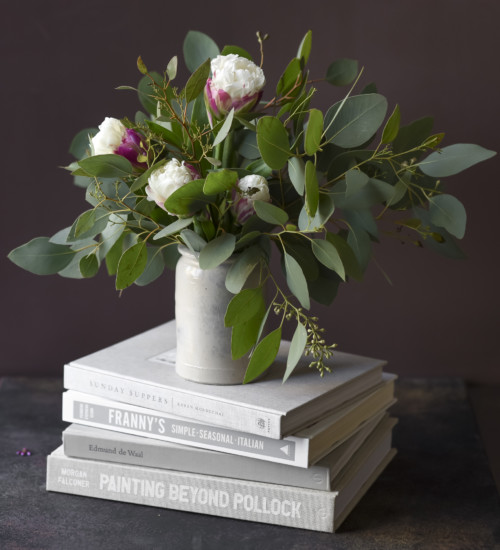Ask Ella: How To Style A “Two Ingredient” Bouquet
Ask Ella is a recurring Garden Collage feature where we ask our in-house florist, Ella Stavonsky, about floral design– including the history of, origin, and maintenance that goes into some of the most intriguing flowers on the market today. This column is dedicated exclusively to common and rare varieties of flowers you’re likely to find at your local market. This week, we spotlight easy bouquets you can make with just two flowers.
Making lavish bouquets is something of a luxury– sometimes all you can get is two bunches from the corner store. Fortunately, that doesn’t mean you have to settle for second best.
Go Green
While it may be tempting to buy two bunches of flowers (more flowers = better, right?), your best bet is to invest in one bloom and one green filler. As their name suggests, fillers tend to take up space and are usually pretty cheap. If you live in a city with a bustling flower market, you can probably get a entire bunch of greens for about $5– and you’ll probably wind up with way more than you need, in which case you hang the rest upside down and dry them for long-lasting décor. (Not sure what kind of greens are right for you? Check out our guide to the most common three out there.)
Opt For Light Colors
When looking for blooms, choose colors that will offset your green filler. Bright, paler hues tend to provide the best contrast, so consider bunches of cottage roses, ranunculus, dahlias, tuberose, stock flower…suffice to say, the list goes on. Which isn’t to say you should avoid color all together– vivid blooms like clematis, snapdragons, and delphiniums add color but have a freshly-picked vibe that keeps the arrangement fresh. While the right combo of dark green and dark flower can work (like ferns and deep purple hellebores), the arrangement risks blending in with its environs, so use them if your space tends towards a brighter, cleaner look.
When adding your flowers, you’ll also want to keep as much of their native leaves as possible, to add texture to the bouquet (as seen above with the bleeding hearts). If you’re looking to add more variety, opt for blooms whose leaves fall above your anticipated water line, like anemones and tulips.
Know Your Base
Vases can make or break a bouquet. Mason jars or other salvaged, plain glassware are always a safe option– and, most likely, the easiest. But if you want to upgrade your look, consider a vase that matches one of the colors in your bouquet. (We did a whole series of vases and single floral counterparts.)
Check Your Garden…Or Your Fridge
If you’re bouquet’s still looking a little sparse, look outside. A small clipping of pine, oak, or even a few sprigs from a bush can add just the right touch. No backyard to pick from? Try looking in your crisper for greens. Carrot tops, parsley, basil, sage, and rosemary can all work as a secondary green, adding texture and hue without incurring additional cost. (We once made a whole bouquet out of groceries!) Plus, they add a fresh scent!



































